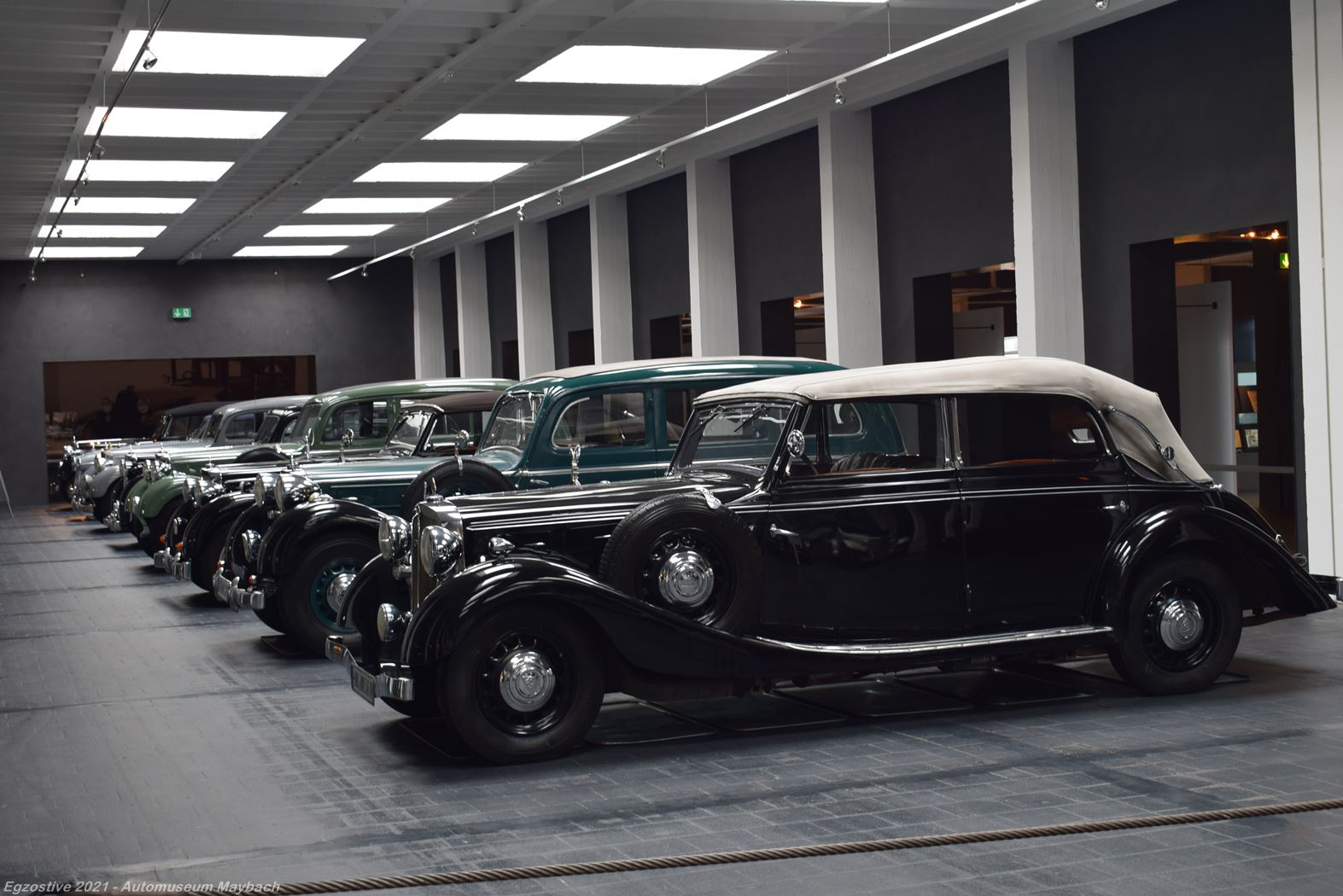The Maybach Museum is the best place to commemorate the brand’s 100th anniversary
The centre stage of the Maybach Museum’s main hall showcases six cars of the top of the line SW38/42 model.

The first one is a classic 1937 Maybach SW 38 that was ordered by Klöckner Steel from Duisburg. After World War II, the French Army confiscated the Maybach and used it as a service vehicle.

Later in the mid-fifties, a US sergeant took the car to the United States. Following its path through several owners, the car found its way into the Maybach Museum.
The light blue car is a really unusual one and stands out of the Art Deco era, thanks to its post-war refurbishing. The 1938 Maybach SW 38/42 was bought by the Press and Rolling Mill Düsseldorf, part of the Thyssen Group.
At that time, the original body was a Pullman-Limousine fabricated by Spohn, in grey-green colour coating with black fenders. The interior of the Limousine was draped with beige cord cloth.
In 1950, the car was taken back by the Maybach-Motorenbau company, and Spohn refurbished the car. They equipped the car with a new HL 42 engine and designed an unusual four-door Cabriolet body. This was the first post-war “Spohn-Ponton-Cabriolet”, a unique accomplishment influenced by the Designer Brook Stevens. The total reconstruction costs added up to 38,000 DM in 1950, almost double than that of a Gullwing Mercedes.
The light grey car had a rougher history, going through the purgatory of the DDR. The grey 1938 Maybach SW 38 was registered to Mr Emil Schlutius, the director of the paper processing plants in Saalfeld / Saale.
The 140 Horsepower limo survived the Second World War and the requisition of the German Wehrmacht and the Red Army unscathed.
In the DDR times, the car was used by local celebrities, and after the fall of the Wall, the Maybach came to West Germany.
The black 1939 Maybach SW 38/42 was delivered to the company of E.Rahlmann. Initially, the car was delivered as a four-door Pullman-Limousine on a long wheel-base, but the car was taken back by its manufacturer,
and the Spohn Company coachbuilt a new, more modern body for the car. After that, the “modernised car” was used as Directors’ Car of the Maybach-Motorenbau.
The Green car is a 1936 Maybach SW 38, sold to Hans Höffkes, in Cologne. At the beginning of World War II, the Maybach was walled in to avoid confiscation by the German Army.
A general refurbishment was undertaken in 1950 at the factory in Friedrichshafen. After the death of Mr Höffkes, his Maybach was standing in a garage for more than 50 years.
The black 1939 Maybach SW 38/42 was equipped with a Sport-Cabriolet body provided by the Spohn Company.
It was ordered by the Minister of Propaganda, Herman Esser. He was an early supporter of the Nazi party and was kept in high positions thanks to his friendship with the Führer, despite his escapades with women.
The car’s fact sheet noted that the public procurement tried to keep the future owner confidential, and the administrative authority did not pay the invoice for an extended period. So the Maybach Company even had to claim interests on arrears.
After the war, the car reappeared in Avignon and was brought back to Germany in 1972. This car could be seen in the film “The Ace of the Aces” with the actor Jean-Paul Belmondo and various TV series.
The back/green 1939 Maybach SW 38 has a clerical background, as it was ordered by the bishop of Trier.
The last car in the main line-up is a black 1937 Maybach SW 38 with a short under-carriage of 3.38 m wheel-base, a Sport-Cabriolet body fabricated by the Spohn.
It was registered an insurance company, the Gerling Group in Cologne. The car was purchased as a company car for Dr Hans Gerling. He was a recurring customer to Maybach, traded in his Maybach W 6 Roadster.
This Maybach SW 38 has a sports convertible chassis, coachbuilt by the Spohn company from Ravensburg, and was featured in several movies of the ‘30s driven by the proud owner on the screen.
The car was spared of drafting during the Second World War and survived the war in the hands of the Gerling family. Following a decade of hiatus, the car was revived in 1968. Since then, it has remained a regular guest of classic car events.
This review proved to be more egzostive exhaustive than I first thought, even if I left out quite a bit from the exhibits and information. The museum is definitely worth the slight detour and undoubtedly a must-see for every Maybach enthusiast.
It is an unrivalled collection of cars and artefacts. The exhibition encompasses several epochs and provides a broad historical context. The architecture is simple but efficient in creating the right mood, with naked concrete and modern styling that gives maximum limelight to the showcased cars.
I passed by the Museum dozens of times, crossing Europe without ever paying a visit. It is ideally located for a short stop on one of Europe’s most important roads (between Nürnberg and Passau), and it is certainly worth a visit.

